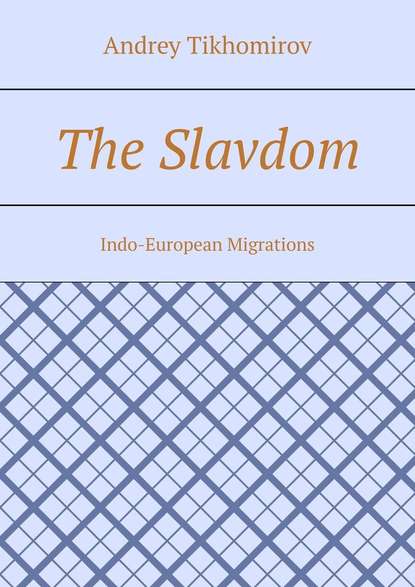По всем вопросам обращайтесь на: info@litportal.ru
(©) 2003-2025.
✖
The Slavdom. Indo-European Migrations
Настройки чтения
Размер шрифта
Высота строк
Поля
Andrey Tikhomirov
Slavic peoples are based on Slavic languages that belong to the Indo-European language family. Modern Slavs are divided into 3 groups: eastern, southern and western. Slavic languages are especially close to the group of Baltic languages, even a special Slavic-Baltic community (2—1 millennia BC) stands out. In even more ancient times, Slavic languages (4—3 millennia BC) were most likely closely associated with Iranian languages.
The Slavdom
Indo-European Migrations
Andrey Tikhomirov
© Andrey Tikhomirov, 2020
ISBN 978-5-4498-2704-3
Created with Ridero smart publishing system
The formation of the Slavic peoples
Slavic peoples are based on Slavic languages that belong to the Indo-European language family. Modern Slavs are divided into 3 groups: eastern, southern and western. Belorussians, Russians and Ukrainians belong to the east, Bulgarians, Bosnians, Macedonians, Serbs, Slovenes, Croats and Montenegrins to the south, Kashubians (the ethnic group of Poles that inhabit part of Polish Pomerania – Kashubia), Luzhans, Poles, Slovaks and Czechs. Now these are states in which the majority of the above Slavic peoples are: Belarus, Russia, Ukraine, Bulgaria, Bosnia and Herzegovina, Northern Macedonia, Serbia, Slovenia, Croatia, Montenegro, Poland, Slovakia and the Czech Republic. Luzhichans (Lusatian Serbs, Sorbians, Vendians) live in eastern Germany.
Slavic peoples are currently distributed in large areas of Eastern and Central Europe, the Balkan Peninsula, Siberia and the Far East. The territory of their distribution throughout history has changed significantly. This is especially true for Russians. In some areas of Europe, Slavic peoples assimilated and disappeared. So it was, for example, on the territory of eastern Germany, the modern toponymy of which testifies to the ancient Slavic population of Brandenburg, Mecklenburg, Saxony and other neighboring regions. Back in the 18th century. Slavic speech was preserved on the Elbe (Slavic Laba) in the Lyukhov district on the River Yetz. The texts of the late 17th – early 18th centuries allow us to judge the Labab language.
Slavic languages are related to other Indo-European languages by the most ancient korneslov and formative. Slavic languages are especially close to the group of Baltic (Baltic) languages, even a special Slavic-Baltic community (2—1 millennia BC) is distinguished. In even more ancient times, Slavic languages (4—3 millennia BC) were most likely closely associated with Iranian languages. In the 1st millennium A.D. Slavic languages entered into various ties with the Germanic languages, as well as with the Greek language.
Of the non-Indo-European languages, the relations of the Slavs with the Ugro-Finns and Turkic peoples were especially significant, which was reflected in the vocabulary of the Slavic languages, especially Russian.
One of the most ancient pre-Slavic cultures is Ludwick, located along the Vistula and Oder. Findings and artifacts of the Lugice culture extend to the coast of the Baltic Sea, in the south they reach the upper Vistula and Danube, in the west – the middle reaches of the Elbe, and in the east – to the Bug and upper Pripyat. The earliest monuments of Lugansk culture date back to the Bronze Age, back to the end of the second millennium BC. However, most of the Luga settlements date back to the middle of the 1st millennium BC. Among them, the ancient village located on the shores of Lake Biskupinsky near the Polish city of Poznan is the most well-studied. The remains of wooden buildings due to soil moisture are well preserved. The village was fenced with a powerful defensive wall, built of three rows of wooden log cabins, filled inside with clay, earth and stones. In the village, eight parallel cobbled streets were opened, along which there were long houses. The arrangement of houses in the form of huge collective dwellings, divided into rooms, indicates that tribal communities lived in them, within which there was already a clear division into families, but families were not yet separated from the clan. Among the finds are many ceramics from various vessels.
Luzhitsky tribes were engaged in agriculture. As a result of excavations, the remains of wooden plow, horny hoes on a wooden handle, iron sickles and simple stone grain grinders were found. Carbonized rye, wheat, barley and pea grains were also found in the Biskupinsky settlement in Poland. Of the fibrous plants, flax was known. Findings made in these houses indicate the absence of any noticeable property differentiation of their inhabitants. The same conclusion should be drawn from the consideration of funerary monuments of this culture, which differ in uniformity and in this respect are completely different, for example, from the barrow cemeteries of Scythia, where there is a sharp property differentiation of the buried. The tribes of Luga culture burned their dead, followed by the burial of urns with ashes on the “funeral field” – a rite very characteristic of the ancient Slavs.
In the I millennium BC among the tribes of Luga culture, iron completely displaces stone, and then bronze, from which only jewelry began to be made. In the 7—6 centuries. BC. The metallurgy of iron spread among the tribes of Luga culture, which was mined by the raw-iron method from local bog ores. Tribes of the Luga culture made various dishes from clay (often covering its surface with glaze), figures of animals and birds, children’s toys, etc.
In the economy of the Luga population, a significant place was also occupied by domestic cattle breeding. There are many bones of domestic animals in the settlements, among them especially cattle bones. The burials of the Luzick culture are known. The deceased were burnt, and the remains of the incineration were enclosed in clay pots, covered with a crock and put into holes. Such pots with mortal remains are called urns. A small number of things were placed near the urns and vessels were placed, apparently with food. Such burial grounds are called “burial fields”, or “fields of burial urns”. The burial rite in urns later became widespread among the Slavs and non-Slavic tribes of Eastern Europe in the first half of the 1st millennium A.D. e.
Related to Luga’s culture was another Proto-Slavic culture – the Black Forest culture, which occupied the interfluve of the Middle Dnieper and the Upper Bug and was named after the Black Forest hillfort in the Ingulse basin, the right tributary of the Dnieper. In the settlements of this culture dating back to the early Iron Age, there are many horny and bone hoes, tools for processing leather, bone arrowheads, darts, psalms from fishing rods and ceramics. Much material of the Black Forest culture was collected on the Subbotinsky settlement. The materials of this settlement testify to the wide development of craft production. In addition to crafts made of bone and ceramics, more than two hundred fragments of foundry molds were found, which served to cast jewelry and Celts, iron things. The Black Forest culture is characterized by a large number of burial grounds of two types – mounds and barrows. Burials, as well as a number of other elements of culture, are close to the monuments of Luzitsky culture.
Milograd culture, prevalent in southern Belarus, mainly along the right bank of the Dnieper, is another Proto-Slavic culture. On the hillforts of this culture, square at the base of the dwellings are slightly deepened into the soil. The population knew the processing of iron and copper. The economy of Milograd residents is well known from excavations. The basis of it was agriculture and cattle breeding. Along with this, fishing and hunting were of auxiliary importance.
Lomonosov M.V. writes in his book “Ancient Russian History” (1754—1758), the book MV Lomonosov, Selected Prose, comp., foreword. and comment V.A. Dmitrieva, 2nd ed., Moscow: Sov. Russia, 1986, p. 217—219: “Chapter 5 ABOUT THE CONJECTIONS AND CASES OF SLAVIC
The oldest of all the Slavs, according to the news of ancient writers, should be revered from Asia to Europe. What happened in two ways, water and dry, from the above is not difficult to see. For Venets from Troy with Antenor sailed the Archipelago, the Mediterranean and the Adriatic Sea. And it is very likely that after this, for different times and occasions, many of their homogeneous people from Paflagonia on the aforementioned path or along the Black Sea and up the Danube to them and in their neighborhood went to live. This is confirmed, firstly, by the fact that Venets spread very widely along the northern and eastern shores of the Adriatic Gulf and along the lands lying on the Danube; the second, that Paflagonia after that from time to time diminished and, finally, did not rely between the main lands in Asia, for Ptolemy (Geogr., book 5, ch. 3.) is already revered as a small part of Galatia.
The other way was from the Medes north, near the Black Sea, to the west and further at midnight, when the Sarmatians, from the Medes descended from the Zadonsky places further to the evening countries, which should be concluded from the truth. Well, Blond writes (Decade 1, book 1.) that the Slavs, from the Bosphorus of Zimmer to Thrace, who lived in Illyrik and in Dalmatia, were resettled. Bulgarians are an ancient dwelling in Asian Sarmatia, near the Volga River, with good justification from some it is believed (Cromer, book 1, chap. 8.), then that Iornand with the Slavs and Antes, Slavic people, their combined attack on the Roman Empire describes and respects them in the northern country from the Black Sea. The name of the Bulgarians, which happened from the Volga, which after that the other peoples, the Kozar and Tatars, from the Russians were called, is consistent with the case (Nestor, in many places.).
All this proves the movement of the Slavic generations from east to west by our vast lands, in the north near the Pontic Sea. Thus, having already stretched to the noon packs, they united with their homodes, who had resettled by the southern road, and for many ages made up different Slavic generations, having canceled the dialects and customs of the communication with the alien peoples whom the persecution addressed.
What courage was the ancient ancestors of the Slavic people, you can learn about it by reading about the wars of Persian, Greek and Roman with the Medes, Sarmatians and Illyrians, which belong to other Russians with other Slavic generations. Although the narrative incredibly seems to us to be of special praise about the letter given from Aleksandr the Great to the Slavic people, I mention it here to those who don’t know that, in addition to our New Yorkers, the Czechs also praise it (Cromer book I. chapter 14).
Meanwhile, when the Slavic tribes from the Medes, near the Black Sea, to Illyrik and to other places spread, then they settled in the northern countries in great numbers. The Novogorodsky chronicler is consistent with external writers. And even though the names of Slaven and Rus and other brothers were fictitious, however, there are affairs of the Northern Slavs described in it, which are not contrary to the truth. In the Varangian Sea, which was given this name from theft in the Chudsk language, usually there were great robberies in ancient times and not only from vile people, but also from reigning rulers were not considered a vice. About Sla-venov’s son of the Magus, from whom the Volkhov bears the name, he writes that in this river he turned into a crocodile and devoured swimming. These things should be understood that the mentioned prince on Lake Ladoga and on Volkhov, or the Mutnaya river then called, robbed and was called his carnivorous beast because of his likeness. The spread of the northern Slavs to the Vym and Pechora rivers, and even to the Ob, although it should later seem to be rather than what is supposed in this chronicler, is not as late as some people think, then after seven hundred years bargaining from Russia to the West has been known for expensive sable furs from external authors, and melons in the Russian merchants had previously appealed than Yermak had opened the entrance to Siberia with a military hand.
When the Roman Empire strengthened and spread its weapons far, then the Slavic peoples who lived in Illyric, in Dalmatia and near the Danube felt its violence, for which they turned north to their homies, who had long lived in it. According to Nesterov (Sheet 4.), the Slavs in the places where Novgorod lived during the preaching of the gospel by the holy Apostle Andrew. Ptolemy (Book 3, Ch. 5, table 8.) laid the Slavs near Velikiye Luki, Pskov, Old Rus and Novgorod.”
Vladimir Chivilikhin in the book “Memory”, M., “Fiction”, 1984, writes (p. 424—425): “The outstanding linguist and historian A. A. Shakhmatov (1864—1920) created capital works on the history of medieval and modern of the Russian language, folk dialects, conducted in-depth studies of the Russian annals, discovered Ermolinskaya, Simeonovskaya and other annals for science, led the publication of the Complete Collection of Russian Annals, created the Dialectological Commission, for several decades worthily leading Russian philological science. The work ‘The Ancient Fates of the Russian Tribe’, published in Petrograd in 1919, which, unfortunately, became known to me later than the fresh books of Menges and Khaburgaev, A. A. Shakhmatov, based on Arabic and Khazar sources, as well as on the annals of that the Vyatichi came ‘from the Poles,’ he writes in the main text: ‘I will stop… on the very name of the Vyatichi: it sounds to the Arabic-Persian writer Gardisi… Vantit.’ The appearance of ‘en’, that is, natural nasal ‘e’ transmission in this name, I explain to myself by the fact that the Vyatichi, as the Lyash tribe, called himself myself We-tic, – whereas their neighboring Slavs pronounced Wje-tic: the nasal sound is perceived as ‘en’ (or ‘em>?) the Khazars, where Vantit Ceyhan and Vuntit Khazar king Joseph.’ And in the note he speaks of Artania from the Arabic sources of the 9th century, who called Artania one of the three main Russian tribes with their city of Arta, and the approximation of these names by the Czech scientist L. Niederle with ancient Antes, although the name of the Ants disappeared by the time of the Arabs’ travels and early medieval Russia from the history. “I also think that between Arta, Artania, on the one hand, Vantit, on the other, there is a connection; but this connection is completely different than the Netherlands thought: Vantit is Vyatichi, and Artania is Erdzian, whence Ryazan; Ryazan, as we have seen, became the city of Vyatichi (cf. the commentary of later chroniclers: Vyatichi, that is, Ryazanians).”
But Ryazan was founded at the end of the 11th century, and where are the Wends (Venets) here as the ancestors of the Vyatichi? Somewhat earlier, the scientist mentions them in connection with the works of the Jordan known to us: “Venets (Venetarum natio) live on the left, north-facing slope of the mountains bordering Dacia (i.e., the Carpathians), and extend to vast spaces, starting with the sources of the Vistula”. Jordan’s story about a trip to the country of Antes Vinitar is also mentioned, the name of which the famous German archaeologist I. Marquardt brought closer to the tribal name of Venets, but A. A. Shakhmatov himself in this work made the following conclusion: “Everything that we know about Ants, with perfect clarity leads us to the recognition of their Eastern Slavs, therefore, the ancestors of Russians. “However, Venets were not called ancestors of Vyatichi in their work! And this was the last published book of the great Russian scientist – a few months later he died in the hungry and cold Petrograd, which exerted forces to defend the revolution …”
At the end of the first millennium BC. As a result of the advance to the south of Pomeranian tribes and ancient Germans from Jutland, a Przeworsk culture developed on the site of the Gluzhitsky culture, the territory of which was much wider. The reasons for this movement are unclear. The settlements of Przeworsk were located in elevated places. People lived in huts, were engaged in agriculture and cattle breeding. Iron sickles, axes, plowshares, and a large number of stucco ceramics are found in the cultural layers of Pshevor settlements. It is believed that it belonged equally to both the ancient Slavs and the ancient Germans. Moreover, it is impossible to territorially divide this culture into the Slavic and Germanic parts, into two regions, since at that time, at the turn of our era, both Germanic and Slavic tribes often changed their position, lived in strips, and the elements of their culture were mixed. The cultures described by us of the 1st millennium BC approximately give an idea of the territory of the formation of the ancient Slavs. However, it cannot be said which of these cultures was the oldest Slavic culture, although in the past there were quite determined attempts to connect one of them with the Slavs.
In the second century BC between the upper reaches of the Western Bug and the Middle Dnieper, that is, in the southern part of Belarus and in the forest-steppe Northern Ukraine, right up to Kiev in the south and Bryansk in the north, a Zarubin culture emerges. It is believed that the centers of the formation of this culture were in the western part of this territory. For four hundred years, the Zarubinets tribes were the only and numerous population of the forest-steppe Dnieper and Polesie, that is, those territories that are considered as ancient Slavic lands in eastern Europe. This culture has absorbed the traditions of a number of Proto-Slavic cultures, developed on their basis and on the territory that they occupied.
Settlements of the Zarubinets culture were located on the steep banks of the rivers, strengthened by tyn. People lived in rectangular ground huts. From the beginning of our era, rectangular half-dugouts, with a gable roof, a fireplace or a stove, have become the predominant type of dwellings. This type of dwelling was preserved until the Middle Ages with almost no changes in most Slavic tribes. There were cellar pits near the dwelling. The basis of the economy was hoe farming and domestic cattle breeding. People raised cows, horses, sheep and pigs. Iron axes, sickles, grain graders, arrowheads, harpoons and fishing hooks, a lot of jewelry and pottery were discovered on the Chaplinsky settlement.
However, the most characteristic of this culture is the so-called fields of funeral urns. This rite was also known among the ancient Slavs, and at the turn of our era it becomes dominant. Near Kiev, two large cemeteries are known – Zarubinetsky and Korchevatovsky. Excavating them, archaeologists met mostly burnt bones and pottery. In addition, there are iron knives, bronze brooches (clasps), pins and bracelets. Sometimes iron tips of spears come across. Among the archaeological materials of the Zarubinets culture, Roman and Celtic things are often found, testifying to the connection of the ancient Slavs with the Black Sea and Western Europe. Over time, the tribes of the Zarubinets culture advance north into the lands of the Baltic states, bringing elements of their culture and, above all, numerous iron products characteristic of the Zarubinets culture. Zarubinets tribes mastered the production of iron in perfection at that time.
Martynov A.I. in the book “Archeology of the USSR”, publishing house “Higher School”, M., 1973, p. 243. writes: “Iron was mined by them from the swamp ores, smelting was carried out in small raw-iron furnaces. Iron objects are very diverse: knives, axes, chisels, celts, chisels, sickles, pink salmon braids, arrowheads and darts, bit and fishing hooks.”
Anatoly Kim in the book “Fedina’s hut”, publishing house “Malysh”, M., 1988, writes about the ancient method of metallurgists (p. 23): “Here, Fedya, once burned coal, and the coal-burner worked at this place named after Aleksashka Zhukov, “explained the grandfather.” Before, all the blacksmiths worked on charcoal, and the factories used that kind of coal. they stood up to each other, made large piles of logs like stacks of logs, then covered these woodpiles with earth, and from below through firewood was lit… Logs were spoiled, but they could not burn with flame, therefore they did not burn into ashes, but were rotted into coal. It took a long time until all the logs were completely smoldered, then they chopped off the crust from it. Under it was coal – hard, sonorous. They smashed him with nuts and stuffed them with baggy bags. These were healthy bags, planted! And in these bags they brought coal out of the woods on sleighs, carts. I also transported winter coal when there was no other business … " Thus, various forms resembling a cross were used in ancient times for ignition.
Modern archaeological research proves that the homeland of the Indo-Europeans is the region of the South Urals, where they formed as a single language group.
Communities are created, first on the basis of common origin – childbirth, and as marketable products increase, a large family community is formed, consisting of phratry, i.e. several genera. Then the neighboring community in the form of a tribe, the next step – the union of tribes, leading, in turn, to the formation of the people, and then the state. But for any community, a community of interests is also necessary, in this case, the protection of metallurgists and their products. So there were settlements of ancient metallurgists, and in particular, the Arkaim culture of the South Urals. Similar settlements were found in Europe, in Germany near Dresden and Leipzig, as well as in Austria and Slovakia, under the age of 7 thousand years. After the end of natural resources, the settlements were “closed”, the ditches were filled up, and the remains of the dwellings were burned.
The country of cities is the conditional name of the territory in the Southern Urals, within which ancient cities and fortified settlements of the Sintash culture of the Middle Bronze Age were found (about 2000 BC), one culture.
Settlements were discovered in the 70s – 80s. XX century. One of the first archaeological complexes found was an ancient settlement on the Sintashty river (a tributary of Tobol), due to which the settlement itself was named after the South Ural River. Soon after the discovery of other cities, archaeologists began to use the term “Sintashta culture.” This “country” is located in the Chelyabinsk region, Orenburg region, Bashkortostan and northern Kazakhstan. Cities are located on the territory with a diameter of 350 km.
All settlements are united by a similar type of structure, the organization of urban infrastructure, building materials, and the existence time. As well as the same topographic logic. The hillforts are clearly visible in aerial photographs. After 4,000 years, the skeletons of cities clearly appear against the backdrop of the natural landscape, plowed fields. There comes an awareness of the skill of the engineers who designed and created such system cities. The cities themselves were most suitable for life. Firstly, they provided protection from external enemies, and secondly, in the cities premises were made for the life and work of artisans, saddlers, potters, and metallurgists. Inside the cities there is a storm sewer that takes water out of the settlement. Near the cities burial grounds were organized, animal pens were built. All fortified settlements were made in three different forms: round (8—9 pieces); oval (about 5); rectangular (about 11). The term “country” appropriately characterizes this location of cities. In addition to the fact that all the fortified settlements were built on a compact territory at the same time, in the same style and using the same engineering solutions, similar materials, other unifying properties are visible.
On the vast territory of the steppes in the ancient era to the west of the Urals lived the tribes of the so-called Srubnaya, and to the east – the Andronovo culture, the latter covering the region from the Urals to Altai and the Yenisei. Andronovites, who spoke one of the dialects of the ancient Iranian language (Indo-European group), raised cattle and small cattle, horses, engaged in fishing. In the southern Urals, traces of floodplain agriculture were also identified. Andronovo society was considered rather backward and archaic, as evidenced, in particular, by the poverty of their burials. Earthenware, bronze jewelry, less often tools and weapons were usually placed in the grave with the deceased.
According to Videvdat (the first book of the Avesta, a collection of sacred books of the ancient Iranian religion, a kind of Iranian continuation of the Vedas), the ancestral home of the ancient Iranians is Airyanem Vaejah (Avest. Airyanem Vaejah, “Aryan space”). This country is described as an endless plain through which the beautiful river Daitya (Vahvi-Datiya) flows.
Indo-European tribes moved from east to west and, like a snow falling from a mountain, they swept away everything in their path, taking in those who joined their tribes. Their ancestral home, where they formed as a single language group, were the steppes of the Black Sea – the Southern Urals.
In the Avesta, the god Ahura Mazda (an extremely knowledgeable priest) advises the legendary immaculate king of the ancient Aryans (Indo-Europeans) Yime to create a giant fence – Varu, and there, for this fence put “the seed of all the males and females that are greatest on this earth, and the seed of all genera cattle, and the seed of all plants. And to do everything in pairs, while people are in Var … " The legendary Vara consisted of 3 circles, enclosed one in another. From the extreme 9 passages were conducted, from the middle – 6, from the internal – 3. And on this territory fenced off from evil winds, Yima built 18 streets, and created a window above the top – something like a chimney for smoke. The patron of forging in the Slavic pagan pantheon was the blacksmith god Svarog (Sanskrit. “Svarga” – heaven). The image of Svarog is close to the Greek Hephaestus and Prometheus.
The sun – Yes-God – in Slavic mythology was thought of as the son of Svarog. The ancient Slavic god – Dazhdbog – the bearer of happiness, most likely symbolizes rain, for example, in Slovak dažď (read “dazhd”) – rain. “Wind is blowing” is an analogy with a man who blows from his mouth. “Blind rain” means – it is raining and the sun is shining, and thus it turns out that it is as if the rain “does not see” and goes where the sun is shining. In the Christian folk calendar, Svarog turned into saints Kozma and Demyan – patrons of blacksmithing and marriage. The very presence of the gods – the patrons of the forging – indicates the antiquity of its origin. With the word “Svarog” the word “Swastika” (Skt.) Is idiomatically similar – a cross with ends bent at right angles, one of the oldest ornamental motifs found among the peoples of India, China, Japan, where the swastika sign had religious significance. Compare also the Slavic words “cook”, “welding”. In the steppes of the Urals-Altai, forging has already reached significant development among the Scythian tribes of the Northern Black Sea region (7—4 centuries BC), as well as among the Sarmatians and Slavs, known in the 4th – 6th centuries. under the name of ants. In the 10—11 centuries. iron and steel products in Russia were widespread and had diverse applications. The ancient metallurgists usually concentrated in their hands both the smelting of iron from the swamp ore, the so-called “cooking” of iron, and the manufacture of various iron products, as well as the forging of copper, tin, silver and gold, especially in jewelry. A hearth was used where clods of swamp ore were covered with coal from below and above, which was ignited and heated to the desired temperature. The molten iron flowed to the bottom of the hearth and formed a viscous mass (crits). The blacksmith took it with pincers and then, forging it with a hammer on the anvil, gave the product the desired shape, knocked slags from the surface and reduced the porosity of the metal. The development of iron led to a significant leap in development. In addition, deposits of tin and copper, and their alloy of bronze, in the habitat of the ancient Indo-Europeans were practically absent, they were imported from other territories. Iron ores were more widespread than copper and tin, iron ores were formed in large quantities under the influence of microorganisms in swamps and stagnant water bodies. And the area of distribution of the ancient Indo-Europeans was precisely characterized by an abundance of lakes and wetlands. Unlike copper and tin, in ancient times iron was mined everywhere from brown iron ore, lake, swamp, and other ores. A prerequisite for the widespread use of iron metallurgy was the use of a raw-cheese process, in which the reduction of iron from ore was achieved at a temperature of 900 degrees, while iron was melted only at a temperature of 1530 degrees, to produce iron by a raw-iron method, the ore was crushed, calcined over an open fire, and then in pits or small clay foci, where charcoal was laid and air was blown by bellows, iron was restored. A scream formed at the bottom of the furnace (compare Krishna from Sanskrit, lit. – “dark, black”, one of the revered gods in Hinduism). – a lump of porous, pasty and heavily contaminated iron, which then had to be subjected to repeated hot forging. Screaming iron was notable for its softness, but already in ancient times a method was discovered for producing harder metal by hardening iron products or cementing them, that is, calcining in bone coal for the purpose of carbonization. The forge – furnace for the production of iron in the cheese-making process was a shallow hole in the ground, to which air from bellows was fed using clay tubes, which we observe in ancient reconstructions of Arkaim, Quintana, Goloring and other villages. Subsequently, these construction schemes began to be considered sacred and were reproduced in various cruciform variations, including in the form of a swastika, primitive domnica had the form of cylindrical structures made of stones or clay, narrowed upwards, hence the appearance of a swastika, a cross with ends bent at right angles. From below, channels were arranged where clay nozzle tubes were inserted, leather furs were attached to them, with their help air was pumped into the furnace. These designs resembled various types of crosses, which were later deified in Hinduism, Buddhism, Christianity.
The North Indian city of Varanasi (the name Var is mentioned in the name of the city, appeared around the 7th century BC), also known as Benares, is still the place of pilgrimage of the Hindus, there is also a mass cremation of the dead. The corpses of believers are burned in plain sight. In antiquity it was also in the vars: priests with horns on their heads and with wings behind their backs burned the dead people – that’s the prototype of hell. The deceased themselves wanted this, since it was believed that with fire they would immediately go to heaven to the gods.
The oldest books of the Veda and Avesta (compare: the Slavic words “to know” and “news”) are actually the primary basis for most of the religions that exist today. The oldest part of the Avesta Ghats are also called (Ghats) – mountains on the Hindustan Peninsula in India (Western and Eastern Ghats), as well as the old Russian word “ghat” – flooring made of logs for passage, passage through a swamp, swamp. Ghats – the steps of the embankment in Varanasi, descending to the Ganges, where the bodies of the dead are burned. All these words are of the same origin.
The cross was revered in pre-Christian cults. His images were discovered during archaeological excavations in different parts of the globe, in particular, in South America and New Zealand. It was established that he served as an object of worship of other nations as a symbol of fire, which was originally mined by the friction of two crossed sticks, a symbol of the sun and eternal life. Already in antiquity, in order to reduce the melting point of metallurgists, they began to use fluorites (fluorspar, fluorites come in different colors: violet, yellow, green, rarely colorless) and could receive steel at a temperature of 1100 – 1200 degrees, instead of 1530—1700 degrees, which allowed to spend less fuel (wood or coal) during steelmaking, getting very durable iron products.
According to “The Tale of Bygone Years”, Kiev was founded by the brothers Kiy, Schek and Horeb, and their sister Lybed. Kuyavia is a historical region in Poland, in the upper reaches of the Notets River and the middle reaches of the Vistula River, in the 1st millennium, the main population of Kuyavia was Kuyavians, from them the name of the region, Kuyavia is one of the Western Slavic tribal groups involved in the formation of the Polish nationality. Cuiabia or Kuyavia – the name of the city of Kiev in the Arabic sources of the X century (Ceyhani and others). The cheek is Czech (Czech. Čech, compare the pike to the Slovak. Šťuka, read “pike”), the legendary ancestor of the Czechs. Khoriv is Horvat (Croatian. “Horvat”, Polish. “Horvath”), the legendary ancestor of the Croats, the “white Croats” originally lived in the upper Dniester. Lybed (Ukrainian: “Lebed”, Belorussian. “Lebed”, Polish. “Łabędź”, Czech. “Labuť”) is a historical region in the southeast of modern Ukraine, where, perhaps, a woman bearing the totemic name Lebed, led the Slavic tribes, this area is mentioned in the Hungarian epos.
Вы ознакомились с фрагментом книги.
Приобретайте полный текст книги у нашего партнера:
Приобретайте полный текст книги у нашего партнера:











